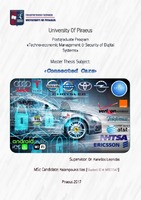Connected cars

View/
Keywords
Vehicle-to-Vehicle ; Telecommunications ; Motorway ; Application software ; Modules ; Autonomous vehicles ; Framework ; EncryptionAbstract
This dissertation was compiled and edited under the University of Piraeus’s Post Graduate Program «Techno-economic Management of Digital Systems». It serves to emphasize the importance of vehicular connectivity as a modern aspect of the IoT world. Through detailed description of the automotive industry and its later tech implementations, an extended reference of automotive technology equipment is issued, including ambient factors, modern safety and information mechanisms and more. Initially, a vehicle – user experience analysis lists all the factors through which the infotainment systems are adjusted to the human behavior, mostly for driving assistance purposes. Up next, official surveys over dedicated analysis, reveal numerous topics, depicting the way governments (authorities) face this new connectivity platform, as new telecom and telematics services are steadily embedded into flagship models, during the last few years. In advance, a few significant value-added services are also listed, providing a clear view of how this connectivity shall enhance the lifestyle, positively and effectively.
Furthermore, the research includes a detailed report, identifying issues regarding connected and autonomous vehicle platform requirements on every single level (technical substance, economic impact, marketing penetration rate, legal barriers etc.). Some of the boldest technical and legal scenarios are applied, offering a certain aspect of today’s accuracy and legality of connected systems, services and applications on modern cars. Through these examples, access issues and data privacy matters are stated (including technology failures, possible hacking cases, remote control attacks, private data access and illegal monitoring), giving the actual “image”, hidden behind the current IoT modernization. Conclusions over legal guidelines are also developed, concerning security and privacy, along with data sharing of sensitive information such as user-vehicle location, access to driver logs, internet browsing history and 3rd parties’ data access scalability.
Closing, various key points are recorded, in both national and international levels, recording main legal entities and data privacy protection vulnerabilities, as well as legal positioning of telecom vendors, 3rd party application developers and car makers in a balanced eco-system. Finally, without skipping suggestions over a safe and guaranteed deployment of connectivity platforms on a massive level, actions that will lead to a universal management system with legal and functional parameters are stated. The final conclusion over the connected vehicle era, leads to crucial approaches for the near future deployments that will prevail around the globe.


